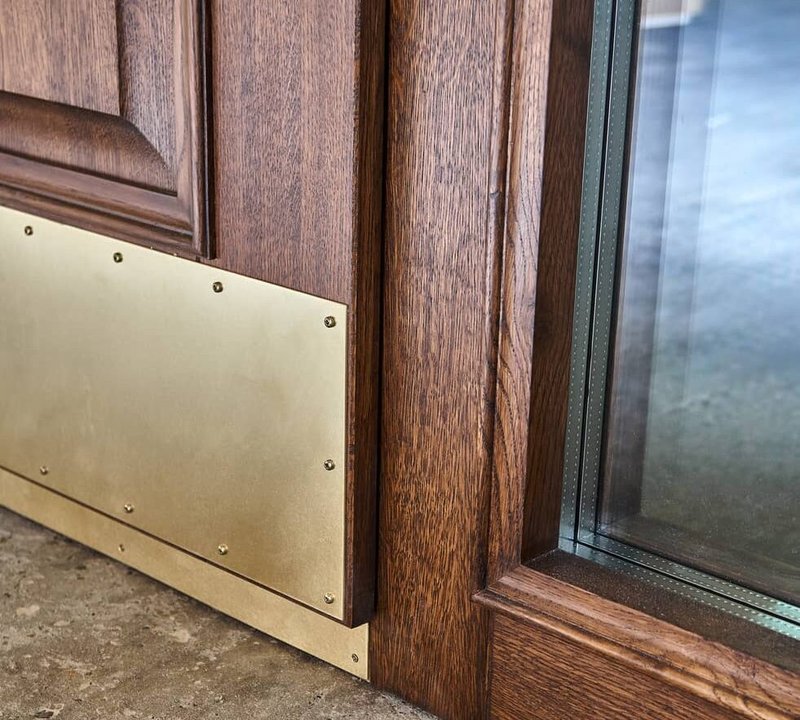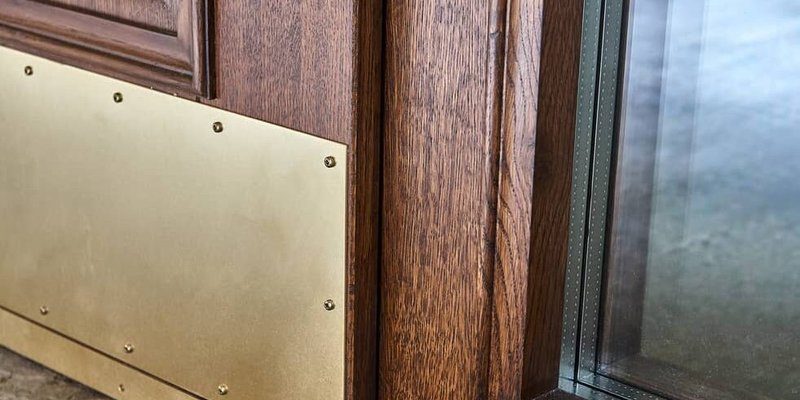
So what’s going on? Kick plates (like the ones from brands such as Schlage or Baldwin) are supposed to handle scuffs and scratches, not turn shabby after a couple of months. But it happens to almost everyone, and there are a few reasons for it. Here’s the thing: kick plates are quietly working overtime, exposed to way more abuse than you might expect. Let me explain why—even if you wipe it down now and then—it still ends up looking dull so fast, and what you can actually do about it.
What Is a Kick Plate and Why Do We Use One?
If you’re new to home hardware, the *kick plate* is that thin metal panel screwed to the bottom section of a door. It’s named for its main job: taking hits from shoes, boots, or even pets who love to scratch and nudge the door. It guards the door’s surface from dents, chips, and stains. Think of it as body armor for the most-battered part of your door.
Kick plates are usually made from brass, stainless steel, or aluminum. Some doors may have plastic or coated options, but metal kick plates are by far the most common. Big brands like Schlage or Baldwin offer several finishes to match your door hardware, from shiny polished brass to satin nickel or classic stainless steel. The whole point is to keep your door looking nice—and to absorb the abuse instead of the wood or paint.
But despite their tough appearance, kick plates are surprisingly prone to looking dull. All those finishes are there for looks, not magic. The finish can wear down, scratch, or get cloudy way sooner than you’d think, especially if you don’t know how to care for it—or if your household is especially “kick-happy.”
The Main Culprits Behind Dull Kick Plates
You might be wondering: why does my kick plate lose its shine so quickly, even if I keep it clean? Here’s what’s really going on.
1. Daily Wear and Tear
Doors get kicked, pushed, scraped with shoes, and even battered by groceries or pet claws. That’s the kick plate’s job, but each little impact causes tiny scratches in the finish. Over time, these micro-scratches make it look faded, dull, or even tarnished. Imagine dragging a stick lightly across a glossy table—after a few dozen times, the shine just disappears.
2. Weather and Moisture
If your door is at all exposed to rain, snow, road salts, or humidity, your kick plate gets an extra assault. Moisture and minerals can react with the metal (especially brass or unsealed metals), leading to dull spots, discoloration, or even corrosion. Even stainless steel can get “tea staining”—those pesky brownish lines—if it’s abused by salt or minerals.
3. Cleaning Mistakes
Here’s a surprise: how you *clean* your kick plate matters a lot. Using harsh cleaners, abrasive sponges, or too much water can wreck the finish fast. Chemical cleaners (especially on brass) can strip away the pretty coating and leave it looking patchy or dull. Honestly, well-meaning cleaning is one of the most common reasons a kick plate starts to look worse, not better.
- Example: Someone scrubs a brass kick plate with a green Scotch-Brite pad and all-purpose spray. It looks great for a minute, then turns cloudy and streaky.
How Your Kick Plate’s Material Affects Its Shine
Not all kick plates are created equal. The material—and especially the finish—changes everything about how long your kick plate will look good.
Polished Brass
Brass can look absolutely gorgeous when new. But unless it’s lacquer-coated, brass tarnishes quickly. Oxygen and moisture cause it to darken and lose its shine. Lacquered/brass looks a little better for a while, but the coating can get scratched or flake off, leading to uneven dullness.
Stainless Steel
Stainless is tough, but not invincible. It doesn’t rust, but it does get fingerprints, “tea staining,” and streaks from harsh cleaners or minerals in tap water. Matte or brushed stainless hides some blemishes better, but it never stays totally flawless.
Aluminum and Other Finishes
Aluminum is lightweight and cheaper but prone to scuffs, oxidation, and fading. Painted or powder-coated kick plates might do better in harsh weather, but the paint can chip or get scratched, showing dull metal underneath.
Pro Tip:
“If you want your kick plate to look shiny longer, choose a material and finish that fits your climate and how rough your household is on doors.”
Common Cleaning Mistakes That Make Things Worse
It’s tempting to give your dull kick plate a hard scrub with whatever cleaner is nearby, but that usually backfires. Here’s why cleaning methods matter:
Using Abrasive Pads or Brushes
Scrubby sponges, steel wool, and even some microfiber cloths can scratch the surface badly enough to strip away that showroom shine. Once the finish is scratched, it’s almost impossible to get it evenly shiny again until you refinish it.
Wrong Cleaners
Harsh chemicals, bleach, or strong degreasers can react with brass or stainless steel finishes. They often leave cloudy, milky stains or streaky residue. Basic dish soap and warm water are usually enough for most finishes.
Not Rinsing or Drying Properly
If you leave soapy water, cleaner residue, or even plain tap water to air-dry, minerals can settle onto the surface and cause dull spots or streaks. Always dry your kick plate with a soft towel to keep minerals from building up.
- Quick cleaning recipe: A few drops of mild dish soap in warm water, a soft cloth for wiping, then a dry towel to finish. That’s it—no scrubbing pads, no bleach, no fancy sprays needed.
Environmental Factors That Speed Up Dulling
Your door’s location matters more than you think. If your kick plate faces the street, it’s exposed to car exhaust, road salts, and dust—extra grime that settles on the metal and dulls it up fast.
Direct Sunlight
Constant sunshine can fade certain finishes (especially painted or coated ones), and UV light can break down lacquer or protective coatings on brass and aluminum.
Humidity and Rain
Damp areas (think coastal homes or shaded porches) mean more moisture lingers, which speeds up spotting and tarnishing. Rain splashes carry minerals and dirt, which dry into a dull film.
Nearby Plants and Dirt
If your porch has planters, gardens, or lots of wind-blown mulch nearby, dust and dirt make their way onto your kick plate. Even pollen and leaf debris can create a fine, gritty paste that grinds down the shine every time someone kicks the door.
- Tip: A covered porch or storm door dramatically reduces grime buildup and gives your kick plate a fighting chance at staying shiny.
Protective Coatings: Help or Hype?
Many kick plates are sold as “lacquered,” “coated,” or “weather-resistant.” These *protective coatings* are a huge selling point, but what do they really do?
Lacquered Brass and Coated Metals
Clear lacquer acts like a shield between the metal and the elements. It can keep brass from tarnishing and slow down grime buildup. But lacquer wears out—especially in high-traffic homes or harsh climates. Once it chips or scratches, moisture sneaks underneath and makes things look even patchier.
Powder-Coated Aluminum or Steel
Powder-coat finishes last longer than paint, and they stand up better to rain and sun. Still, a deep scratch or dent exposes raw metal, inviting oxidation and dullness.
Uncoated or Aged-Look Kick Plates
Some styles come intentionally uncoated for a “living finish” that will develop a patina over time. If you like vintage charm, that’s great! If not, be ready for plenty of dullness (and frequent polishing if you want to fight it).
Insight:
“No coating is forever. Even the best will eventually break down—especially if the kick plate isn’t cleaned gently or is in a tough location.”
Best Practices for Keeping Your Kick Plate Shiny
Alright, so, what can you actually do to keep that kick plate from looking sad and dull before its time? Here’s a simple, low-maintenance strategy.
- Regular Gentle Cleaning: Wipe down the kick plate with a soft, damp cloth every week or two—no scrubbing, just basic dust and dirt removal.
- Avoid Harsh Products: Skip chemical or abrasive products. For tough spots, use a tiny amount of gentle glass cleaner or dish soap.
- Dry It Off: Don’t let water air-dry on the metal. Minerals in tap water can leave spots and streaks.
- Polish When Needed: For brass, a tiny dab of polish (made for lacquered or unlacquered brass, depending on your style) can restore shine. Always follow the product’s directions!
- Protective Wax: Some people swear by a thin coat of car wax or furniture wax, gently buffed in, to add short-term protection—especially before winter or rainy seasons.
- Check for Damage: If you spot scratches through the coating, touch them up promptly to stop moisture from getting in and spreading dullness.
The reality is, even the best-maintained kick plate will show some wear over time. But with a few minutes’ care each month, you can keep it looking sharp for much longer than if you just let it fend for itself.
When Should You Replace or Upgrade Your Kick Plate?
So you’ve tried cleaning, but the dullness won’t budge—or the finish is flaking, peeling, or pitted. When does it make sense to replace the whole kick plate?
Heavily Scratched or Chipped Finish
If the protective coating is shot and metal is exposed everywhere, you’re fighting a losing battle. Moisture will keep creeping in, and the dull patches will get worse.
Permanent Tarnish or Corrosion
Sometimes, brass gets a greenish or black tarnish that just won’t polish out. Aluminum or steel might show white, chalky spots or deep stains. These are signs the metal itself has changed, and it probably won’t shine up again.
Upgrading to a Better Material
If your old kick plate was a bargain version and never looked good for long, you might want to try a higher-quality option. Stainless steel (especially in a brushed finish) or powder-coated plates often stay presentable the longest, especially in harsher climates.
Opinion:
“It’s worth spending a few extra dollars on a kick plate you actually like looking at—since it’s one of the first things you (and visitors) see every day.”
Final Thoughts: Shiny for Now, But Not Forever
Honestly, keeping a kick plate shiny is a bit like keeping white sneakers clean—possible, but it takes some effort. Between footsteps, weather, and even your best cleaning intentions, dullness creeps in fast. But understanding *why* your kick plate looks dull (daily abuse, weather, cleaning mistakes, or finish breakdown) helps you fight back smarter.
If you’re using a Schlage, Baldwin, or any other brand, just remember: no kick plate is immune, but a little regular care keeps that first impression looking bright. And when it’s finally time for a swap, you’ll know exactly what to look for—so your next kick plate keeps its shine a lot longer.
